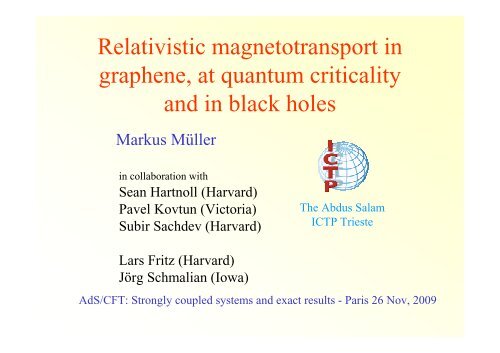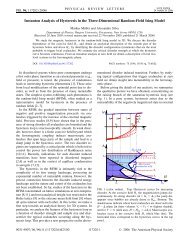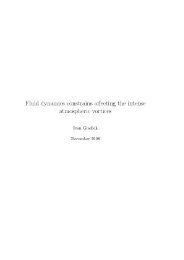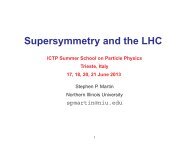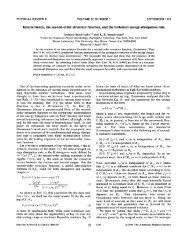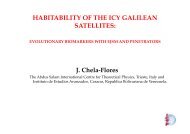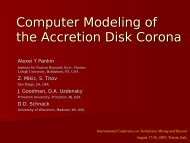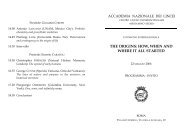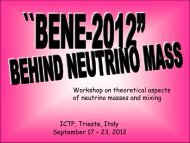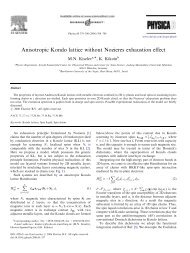Relativistic magnetotransport in graphene, at quantum ... - ICTP
Relativistic magnetotransport in graphene, at quantum ... - ICTP
Relativistic magnetotransport in graphene, at quantum ... - ICTP
Create successful ePaper yourself
Turn your PDF publications into a flip-book with our unique Google optimized e-Paper software.
<strong>Rel<strong>at</strong>ivistic</strong> <strong>magnetotransport</strong> <strong>in</strong><br />
<strong>graphene</strong>, <strong>at</strong> <strong>quantum</strong> criticality<br />
and <strong>in</strong> black holes<br />
Markus Müller<br />
<strong>in</strong> collabor<strong>at</strong>ion with<br />
Sean Hartnoll (Harvard)<br />
Pavel Kovtun (Victoria)<br />
Subir Sachdev (Harvard)<br />
Lars Fritz (Harvard)<br />
Jörg Schmalian (Iowa)<br />
The Abdus Salam<br />
<strong>ICTP</strong> Trieste<br />
AdS/CFT: Strongly coupled systems and exact results - Paris 26 Nov, 2009
Outl<strong>in</strong>e<br />
• <strong>Rel<strong>at</strong>ivistic</strong> physics <strong>in</strong> <strong>graphene</strong>, <strong>quantum</strong> critical<br />
systems and conformal field theories<br />
• Strong coupl<strong>in</strong>g fe<strong>at</strong>ures <strong>in</strong> collision-dom<strong>in</strong><strong>at</strong>ed<br />
transport – as <strong>in</strong>spired by AdS-CFT results<br />
• Comparison with strongly coupled fluids<br />
(via AdS-CFT)<br />
• Graphene: an almost perfect <strong>quantum</strong> liquid
Quantum critical systems <strong>in</strong><br />
condensed m<strong>at</strong>ter<br />
A few examples<br />
• Graphene<br />
• High Tc<br />
• Superconductor-to-<strong>in</strong>sul<strong>at</strong>or<br />
transition (<strong>in</strong>teraction driven)
Dirac fermions <strong>in</strong> <strong>graphene</strong><br />
Honeycomb l<strong>at</strong>tice of C <strong>at</strong>oms<br />
2 massless Dirac cones <strong>in</strong><br />
the Brillou<strong>in</strong> zone:<br />
(Subl<strong>at</strong>tice degree of<br />
freedom ↔ pseudosp<strong>in</strong>)<br />
Fermi velocity (speed of light”)<br />
Close to the two<br />
Fermi po<strong>in</strong>ts K, K’:<br />
Coulomb <strong>in</strong>teractions: F<strong>in</strong>e structure constant<br />
v<br />
F<br />
6 c<br />
≈1.<br />
1⋅10<br />
m s ≈<br />
300<br />
(Semenoff ’84, Haldane ‘88)<br />
Tight b<strong>in</strong>d<strong>in</strong>g dispersion<br />
H<br />
→<br />
≈<br />
p<br />
( p − K)<br />
⋅<br />
r<br />
v p − K<br />
=<br />
r<br />
F<br />
2<br />
e<br />
α ≡<br />
ε hv<br />
F<br />
r<br />
r<br />
σ<br />
vF subl<strong>at</strong>tice<br />
E<br />
= O<br />
( 1)
<strong>Rel<strong>at</strong>ivistic</strong> fluid <strong>at</strong> the Dirac po<strong>in</strong>t<br />
D. Sheehy, J. Schmalian, Phys. Rev. Lett. 99, 226803 (2007).<br />
• <strong>Rel<strong>at</strong>ivistic</strong> plasma physics of <strong>in</strong>teract<strong>in</strong>g particles and holes!<br />
Crossover:<br />
T = μ<br />
Timp<br />
~ ρimp<br />
μ
<strong>Rel<strong>at</strong>ivistic</strong> fluid <strong>at</strong> the Dirac po<strong>in</strong>t<br />
D. Sheehy, J. Schmalian, Phys. Rev. Lett. 99, 226803 (2007).<br />
• <strong>Rel<strong>at</strong>ivistic</strong> plasma physics of <strong>in</strong>teract<strong>in</strong>g particles and holes!<br />
• Strongly coupled, nearly <strong>quantum</strong> critical fluid <strong>at</strong> μ = 0<br />
Strong coupl<strong>in</strong>g!<br />
“Quantum critical”<br />
Crossover:<br />
T = μ<br />
Timp<br />
~ ρimp<br />
μ
Other rel<strong>at</strong>ivistic fluids:<br />
• Systems close to <strong>quantum</strong> criticality (with z = 1)<br />
Example: Superconductor-<strong>in</strong>sul<strong>at</strong>or transition (Bose-Hubbard model)<br />
rel ≈<br />
−1<br />
τ<br />
kBT h<br />
Maximal possible relax<strong>at</strong>ion r<strong>at</strong>e!<br />
• Conformal field theories<br />
E.g.: strongly coupled Yang-Mills theories<br />
→ Exact tre<strong>at</strong>ment via AdS-CFT correspondence<br />
Damle, Sachdev (1996, 1997)<br />
Bhaseen, Green, Sondhi (2007).<br />
Hartnoll, Kovtun, MM, Sachdev (2007)<br />
C. P. Herzog, P. Kovtun, S. Sachdev, and D. T. Son (2007)<br />
Hartnoll, Kovtun, MM, Sachdev (2007)
Strongly correl<strong>at</strong>ed electrons: Cupr<strong>at</strong>e high T c<br />
Thermoelectric<br />
measurements.<br />
Example: Anomalously<br />
large Nernst Effect!<br />
(“thermal analogue” of<br />
the Hall effect)<br />
Conformal<br />
field theory?
Simplest example exhibit<strong>in</strong>g “<strong>quantum</strong><br />
critical” fe<strong>at</strong>ures:<br />
Graphene
Questions<br />
• Transport characteristics <strong>in</strong> the<br />
strongly coupled rel<strong>at</strong>ivistic plasma?<br />
• Response functions, nearly universal<br />
transport coefficients<br />
• Graphene as a nearly perfect and<br />
possibly turbulent <strong>quantum</strong> fluid<br />
(like the quark-gluon plasma)<br />
<strong>Rel<strong>at</strong>ivistic</strong>,<br />
Strong coupl<strong>in</strong>g<br />
regime<br />
T = μ<br />
T<br />
imp<br />
μ<br />
~ ρ<br />
imp
Graphene – Fermi liquid?<br />
1. Tight b<strong>in</strong>d<strong>in</strong>g k<strong>in</strong>etic energy<br />
→ massless Dirac quasiparticles<br />
2. Coulomb <strong>in</strong>teractions:<br />
Unexpectedly strong!<br />
→ nearly <strong>quantum</strong> critical!<br />
Coulomb only marg<strong>in</strong>ally irrelevant for μ = 0!<br />
RG:<br />
(μ = 0)<br />
(μ > 0)<br />
< μ :<br />
2<br />
e<br />
α ≡<br />
εhv<br />
F<br />
= O<br />
T Screen<strong>in</strong>g kicks <strong>in</strong>, short ranged Cb irrelevant<br />
( 1)<br />
Strong<br />
coupl<strong>in</strong>g!
Strong coupl<strong>in</strong>g <strong>in</strong> undoped <strong>graphene</strong><br />
Inelastic sc<strong>at</strong>ter<strong>in</strong>g r<strong>at</strong>e<br />
(Electron-electron <strong>in</strong>teractions)<br />
Relax<strong>at</strong>ion r<strong>at</strong>e ~ T,<br />
like <strong>in</strong> <strong>quantum</strong> critical systems!<br />
Fastest possible r<strong>at</strong>e!<br />
MM, L. Fritz, and S. Sachdev, PRB ‘08.<br />
μ >> T: standard 2d<br />
Fermi liquid<br />
μ < T: strongly<br />
coupled rel<strong>at</strong>ivistic<br />
liquid<br />
“Heisenberg uncerta<strong>in</strong>ty pr<strong>in</strong>ciple for well-def<strong>in</strong>ed quasiparticles”<br />
( ) 1 2<br />
~ k T E τ ~ α k T<br />
−<br />
≥ Δ = h<br />
Eqp B<br />
<strong>in</strong>t ee B<br />
As long as α(T) ~ 1, energy uncerta<strong>in</strong>ty is s<strong>at</strong>ur<strong>at</strong>ed, sc<strong>at</strong>ter<strong>in</strong>g is maximal<br />
→ Nearly universal strong coupl<strong>in</strong>g fe<strong>at</strong>ures <strong>in</strong> transport,<br />
similarly as <strong>at</strong> the 2d superfluid-<strong>in</strong>sul<strong>at</strong>or transition [Damle, Sachdev (1996, 1997)]<br />
−<br />
τ<br />
1<br />
ee<br />
−1<br />
τ ee<br />
=<br />
2<br />
~ α<br />
( k T )<br />
C B<br />
hμ<br />
kBT h<br />
2
Consequences for transport<br />
1. -Collisionlimited conductivity σ <strong>in</strong> clean undoped <strong>graphene</strong>;<br />
-Collisionlimited sp<strong>in</strong> diffusion D s <strong>at</strong> any dop<strong>in</strong>g<br />
2. Graphene - a perfect <strong>quantum</strong> liquid: very small viscosity η!<br />
3. Emergent rel<strong>at</strong>ivistic <strong>in</strong>variance <strong>at</strong> low frequencies!<br />
Despite the break<strong>in</strong>g of rel<strong>at</strong>ivistic <strong>in</strong>variance by<br />
• f<strong>in</strong>ite T,<br />
• f<strong>in</strong>ite μ,<br />
• <strong>in</strong>stantaneous 1/r Coulomb <strong>in</strong>teractions<br />
Collision-dom<strong>in</strong><strong>at</strong>ed transport → rel<strong>at</strong>ivistic hydrodynamics:<br />
a) Response fully determ<strong>in</strong>ed by covariance, thermodynamics, and σ, η<br />
b) Collective cyclotron resonance <strong>in</strong> small magnetic field (low frequency)<br />
Hydrodynamic regime:<br />
(collision-dom<strong>in</strong><strong>at</strong>ed)<br />
τ<br />
− 1<br />
ee >><br />
τ<br />
−1<br />
imp<br />
, ω , ω<br />
typ<br />
c<br />
AC
Collisionlimited conductivities<br />
Damle, Sachdev, (1996).<br />
Fritz et al. (2008), Kashuba (2008)<br />
F<strong>in</strong>ite charge or sp<strong>in</strong> conductivity <strong>in</strong> a pure system (for μ = 0 or B = 0) !<br />
• Key: Charge or sp<strong>in</strong> current without momentum<br />
(particle/sp<strong>in</strong> up)<br />
(hole/sp<strong>in</strong> down)<br />
σ<br />
Drude<br />
J s,<br />
c ≠<br />
r<br />
0,<br />
• F<strong>in</strong>ite collision-limited conductivity!<br />
e<br />
= ρτ → σ<br />
m<br />
but<br />
P r<br />
( μ = 0)<br />
~<br />
k<br />
e<br />
T v<br />
Marg<strong>in</strong>al irrelevance of Coulomb:<br />
=<br />
0<br />
B<br />
2<br />
Pair cre<strong>at</strong>ion/annihil<strong>at</strong>ion<br />
leads to current decay<br />
⎛<br />
⎜<br />
e<br />
⎝<br />
σ<br />
( μ = 0) < ∞ ; σ ( μ ≠ 0)<br />
= ∞<br />
( μ;<br />
B<br />
2<br />
0)<br />
∝ v < ∞,<br />
• F<strong>in</strong>ite collision-limited sp<strong>in</strong> diffusivity! Ds = Fτ<br />
ee<br />
• Only marg<strong>in</strong>al irrelevance of Coulomb:<br />
Maximal possible relax<strong>at</strong>ion r<strong>at</strong>e ~ T<br />
−1<br />
2 kBT τ ee ≈ α<br />
h<br />
→ Nearly universal conductivity <strong>at</strong> strong coupl<strong>in</strong>g<br />
2<br />
2<br />
( kBT<br />
) h 1 e<br />
~<br />
2 2<br />
2<br />
( hv)<br />
⎟α k T α h<br />
⎟<br />
⎞<br />
4<br />
α ≈<br />
log<br />
⎠<br />
B<br />
( ) 1 <<br />
Λ T<br />
Expect s<strong>at</strong>ur<strong>at</strong>ion<br />
as α →1, and<br />
eventually phase<br />
transition to<br />
<strong>in</strong>sul<strong>at</strong>or
Boltzmann approach<br />
Boltzmann equ<strong>at</strong>ion <strong>in</strong> Born approxim<strong>at</strong>ion<br />
⎛<br />
⎜<br />
⎝<br />
a.) +, i +, i<br />
−, i<br />
∂ ⎞<br />
+ eE⋅<br />
⎟ f<br />
∂k<br />
⎠<br />
Cb<br />
2<br />
( k,<br />
t)<br />
= I [ k,<br />
t | { f ( k′<br />
, t)<br />
} ] ∝ α ( T )<br />
∂ t<br />
±<br />
coll<br />
±<br />
b.)<br />
−, i<br />
1<br />
2<br />
−<br />
+, i +, i<br />
−, i<br />
+, i +, i<br />
+, i<br />
+, i<br />
−, i<br />
−<br />
2<br />
L. Fritz, J. Schmalian, MM, and S. Sachdev, PRB 2008<br />
+(N − 1)<br />
+, i +, i<br />
−, j<br />
−, j<br />
2<br />
+(N − 1)<br />
+, i +, i +, i +, i<br />
2<br />
+, i<br />
Collision-limited conductivity:<br />
+, i<br />
+(N − 1)<br />
+, j<br />
0.<br />
76<br />
σ ( μ = 0)<br />
= 2<br />
α<br />
+, j<br />
e<br />
2<br />
( T ) h<br />
+, i +, j<br />
−, j<br />
2<br />
−, i<br />
2
Transport and thermoelectric<br />
response <strong>at</strong> low frequencies?<br />
Hydrodynamic regime:<br />
(collision-dom<strong>in</strong><strong>at</strong>ed)<br />
τ<br />
− 1<br />
ee >><br />
ω,<br />
τ , ω<br />
−1<br />
imp<br />
th<br />
cyclo
Hydrodynamics<br />
Hydrodynamic collision-dom<strong>in</strong><strong>at</strong>ed regime<br />
Long times,<br />
Large scales<br />
• Local equilibrium established:<br />
• Study relax<strong>at</strong>ion towards global equilibrium<br />
• Slow modes: Diffusion of the density of conserved quantities:<br />
t<br />
• Charge<br />
• Momentum<br />
• Energy<br />
>> τ ee<br />
Tloc r ( ) , μloc( r)<br />
; r<br />
u loc( r)
<strong>Rel<strong>at</strong>ivistic</strong> Hydrodynamics<br />
S. Hartnoll, P. Kovton, MM, and S. Sachdev, Phys. Rev. B 76, 144502 (2007).<br />
Conserv<strong>at</strong>ion laws (equ<strong>at</strong>ions of motion):<br />
Charge conserv<strong>at</strong>ion<br />
Energy/momentum conserv<strong>at</strong>ion<br />
1<br />
T<br />
τ<br />
imp<br />
0ν<br />
μ μ<br />
1. Construct entropy current S = Q T<br />
2. Second law of thermodynamics<br />
3. Covariance<br />
∂<br />
μ<br />
μS ≥<br />
0<br />
Irrelevant <strong>at</strong> small k
Thermoelectric response<br />
S. Hartnoll, P. Kovton, MM, and S. Sachdev, Phys. Rev. B 76, 144502 (2007).<br />
Thermo-electric response<br />
Charge and he<strong>at</strong> current:<br />
Transverse thermoelectric response (Nernst)<br />
J<br />
Q<br />
μ<br />
μ<br />
=<br />
μ<br />
ρ −<br />
= u<br />
( ) μ μ<br />
ε + P u − μ J<br />
Recipe: i) Solve l<strong>in</strong>earized hydrodynamic equ<strong>at</strong>ions<br />
ii) Read off the response functions (Kadanoff & Mart<strong>in</strong> 1960)<br />
ν<br />
μ<br />
etc.
Collective cyclotron resonance<br />
S. Hartnoll and C Herzog, 2007;<br />
<strong>Rel<strong>at</strong>ivistic</strong> magnetohydrodynamics: pole <strong>in</strong> AC response<br />
Pole <strong>in</strong> the response<br />
c<br />
FL<br />
2<br />
c<br />
( ε + P)<br />
v<br />
m<br />
ω ωc<br />
iγ<br />
− ± =<br />
∗<br />
Collective cyclotron frequency of the rel<strong>at</strong>ivistic plasma<br />
ρ B c<br />
ω = ↔ ω<br />
Broaden<strong>in</strong>g of resonance:<br />
F<br />
MM, and S. Sachdev, 2008<br />
=<br />
e<br />
γ = σ<br />
B<br />
Q<br />
2 ( B c)<br />
2 ( ε + P)<br />
/ v<br />
Observable <strong>at</strong> room temper<strong>at</strong>ure <strong>in</strong> the GHz regime!<br />
c<br />
F
Yes!<br />
<strong>Rel<strong>at</strong>ivistic</strong> hydrodynamics<br />
from microscopics<br />
Does rel<strong>at</strong>ivistic hydro really apply to <strong>graphene</strong><br />
even though Coulomb <strong>in</strong>teractions break rel<strong>at</strong>ivistic<br />
<strong>in</strong>variance?<br />
Key po<strong>in</strong>t: There is a zero (“momentum”) mode of the collision <strong>in</strong>tegral<br />
due to transl<strong>at</strong>ional <strong>in</strong>variance of the <strong>in</strong>teractions<br />
The dynamics of the zero mode under an AC driv<strong>in</strong>g field (coupl<strong>in</strong>g it to other<br />
modes) reproduces rel<strong>at</strong>ivistic hydrodynamics <strong>at</strong> low frequencies exactly.<br />
Condition: <strong>Rel<strong>at</strong>ivistic</strong>, weak-coupl<strong>in</strong>g quasiparticle picture applies
Beyond weak coupl<strong>in</strong>g<br />
approxim<strong>at</strong>ion:<br />
Graphene<br />
↔<br />
Very strongly coupled, critical<br />
rel<strong>at</strong>ivistic liquids?<br />
AdS – CFT !
Au+Au collisions <strong>at</strong> RHIC<br />
Quark-gluon plasma is described<br />
by QCD (nearly conformal,<br />
critical theory)<br />
_<br />
Low viscosity fluid!
Compare <strong>graphene</strong> to<br />
Strongly coupled rel<strong>at</strong>ivistic liquids<br />
Response for special strongly coupled rel<strong>at</strong>ivistic fluids<br />
(maximally supersymmetric SU(N) Yang Mills theory with N<br />
→ ∞ colors)<br />
By mapp<strong>in</strong>g to weakly coupled gravity problem:<br />
AdS (gravity) ↔ CFT 2+1 [SU(N>>1)]<br />
weak coupl<strong>in</strong>g ↔ strong coupl<strong>in</strong>g<br />
S. Hartnoll, P. Kovtun, MM, S. Sachdev (2007)<br />
Obta<strong>in</strong> exact results for transport via the AdS–CFT correspondence
SU(N) transport from AdS/CFT<br />
Gravit<strong>at</strong>ional dual to SUSY SU(N)-CFT 2+1 : E<strong>in</strong>ste<strong>in</strong>-Maxwell theory<br />
It has a black hole solution (with electric and magnetic charge):<br />
AdS 3+1<br />
Black hole<br />
(embedded <strong>in</strong> M theory as )<br />
z = 0<br />
Electric charge q and magnetic charge h<br />
↔ μ and B for the CFT
SU(N) transport from AdS/CFT<br />
Gravit<strong>at</strong>ional dual to SUSY SU(N)-CFT 2+1 : E<strong>in</strong>ste<strong>in</strong>-Maxwell theory<br />
AdS 3+1<br />
Black hole<br />
(embedded <strong>in</strong> M theory as )<br />
It has a black hole solution (with electric and magnetic charge):<br />
z = 0<br />
Background ↔ Equilibrium<br />
Transport ↔ Perturb<strong>at</strong>ions <strong>in</strong> g tx,<br />
ty , Ax,<br />
y .<br />
( ) 2<br />
2<br />
Response via Kubo formula from δ I δ g,<br />
A .
Compare <strong>graphene</strong> to<br />
Strongly coupled rel<strong>at</strong>ivistic liquids<br />
S. Hartnoll, P. Kovtun, MM, S. Sachdev (2007)<br />
Obta<strong>in</strong> exact results via str<strong>in</strong>g theoretical AdS–CFT correspondence<br />
• Confirm the results of hydrodynamics: response functions σ(ω), resonances<br />
• Calcul<strong>at</strong>e the transport coefficients for a strongly coupled theory!<br />
3 2<br />
shear<br />
SUSY - SU(N): σ ( μ = 0 ) = N ; ( μ = )<br />
Interpret<strong>at</strong>ion:<br />
2<br />
9<br />
e<br />
h<br />
2<br />
η<br />
s<br />
0 =<br />
1 h<br />
4π<br />
k<br />
3 2<br />
N effective degrees of freedom, strongly coupled: τT = O(1)<br />
B
Graphene – a nearly perfect liquid!<br />
Anomalously low viscosity (like quark-gluon plasma)<br />
“Heisenberg”<br />
Doped Graphene &<br />
Fermi liquids:<br />
(Khal<strong>at</strong>nikov etc)<br />
Undoped Graphene:<br />
Conjecture from<br />
AdS-CFT:<br />
η<br />
η<br />
η<br />
~ E qpτ<br />
≥ 1<br />
s<br />
2<br />
∝ n ⋅mv<br />
⋅τ<br />
Exact (Boltzmann-Born Approx):<br />
→<br />
MM, J. Schmalian, and L. Fritz, (PRL 2009)<br />
shear viscosity<br />
entropy density<br />
n ⋅ E<br />
F<br />
⋅<br />
hE<br />
( ) 2<br />
k T<br />
B<br />
Measure of strong coupl<strong>in</strong>g:<br />
η<br />
= ><br />
s<br />
h<br />
kB<br />
1<br />
4π<br />
2<br />
∝ n ⋅mv<br />
⋅τ<br />
→ nth<br />
⋅k<br />
BT<br />
⋅ = n s ∝ k<br />
2<br />
2 th<br />
Bnth<br />
α kBT<br />
α<br />
F<br />
h<br />
T<br />
s ∝ kBn<br />
E<br />
h<br />
F<br />
η h ⎛ EF<br />
⎞<br />
~ ⎜ ⎟<br />
s k ⎝ T ⎠<br />
B<br />
3
Graphene α<br />
= 1<br />
T. Schäfer, Phys. Rev. A 76, 063618 (2007).<br />
A. Turlapov, J. K<strong>in</strong>ast, B. Clancy, Le Luo, J. Joseph, J. E. Thomas, J. Low Temp. Phys. 150, 567 (2008)
Electronic consequences of low viscosity?<br />
Electronic turbulence <strong>in</strong> clean, strongly coupled <strong>graphene</strong>?<br />
(or <strong>at</strong> <strong>quantum</strong> criticality!)<br />
Reynolds number:<br />
Strongly driven mesoscopic systems: (Kim’s group [Columbia])<br />
L = 1μm<br />
u<br />
T<br />
typ<br />
=<br />
0.<br />
1v<br />
= 100K<br />
Re ~ 10 −100<br />
MM, J. Schmalian, L. Fritz, (PRL 2009)<br />
Complex fluid dynamics!<br />
(pre-turbulent flow)<br />
New phenomenon <strong>in</strong> an<br />
electronic system!
Summary<br />
• Undoped <strong>graphene</strong> is strongly<br />
coupled <strong>in</strong> a large temper<strong>at</strong>ure w<strong>in</strong>dow!<br />
Strong<br />
coupl<strong>in</strong>g<br />
• Nearly universal strong coupl<strong>in</strong>g fe<strong>at</strong>ures <strong>in</strong> transport;<br />
many similarities with strongly coupled critical fluids<br />
(described by AdS-CFT)<br />
• Emergent rel<strong>at</strong>ivistic hydrodynamics <strong>at</strong> low frequency<br />
• Graphene: Nearly perfect <strong>quantum</strong> liquid!<br />
→ Possibility of complex (turbulent?) current flow <strong>at</strong> high bias


